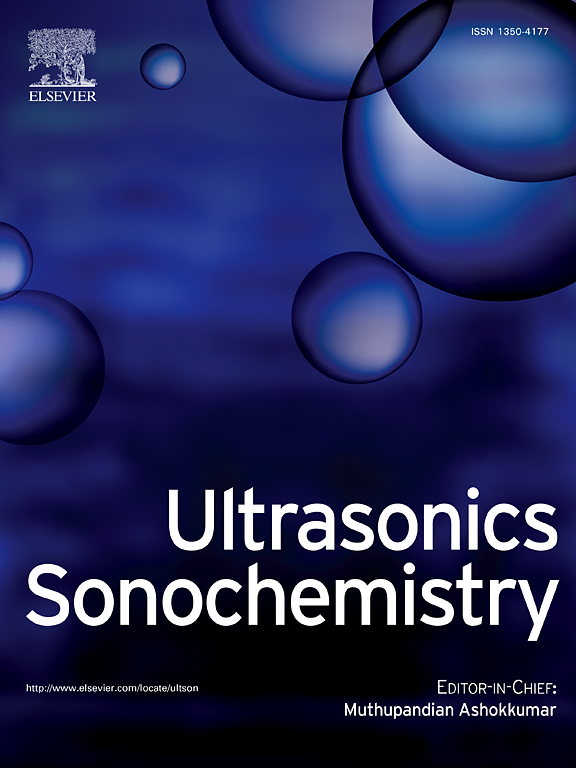Theoretical modeling and experimental validation of laser-generated focused ultrasound and micro-cavitation dynamics
IF 9.7
1区 化学
Q1 ACOUSTICS
引用次数: 0
Abstract
This study presents a fully coupled numerical simulation method for modeling the behavior of laser-generated focused ultrasound (LGFU) in complex structures, including in vivo environments. Using finite element method (FEM) simulations, we achieve peak pressures of 241 MPa and 34.7 MPa in the positive and negative phases, respectively, of the LGFU waveform. The use of adaptive mesh refinement (AMR) enables us to perform tight mesh simulations with a size of 0.06 μm and calculate ultrafast rise time (0.8 ns) of the LGFU wavefront. We also propose an improved LGFU-induced bubble model that can simulate nano-sized seed bubbles, which is achieved by combining the Gilmore equation with heat and mass transfer and modified Young-Laplace (MY-L) equations. We demonstrate the effectiveness of the model by validating it against experimental results in water, where we achieve a 29.6 % improvement in maximum bubble size and a 34.5 % improvement in bubble lifetime compared to the previous model. Furthermore, we apply the model to a tissue mimicking phantom and obtain results that are consistent with experimental observations. Our proposed simulation method provides a powerful tool for investigating LGFU-induced bubble behavior in complex structures, which could have important applications in fields such as biomedical engineering.
© 2017 Elsevier Inc. All rights reserved.
激光聚焦超声与微空化动力学的理论建模与实验验证
本研究提出了一种全耦合数值模拟方法,用于模拟复杂结构(包括体内环境)中激光产生聚焦超声(LGFU)的行为。利用有限元法(FEM)模拟,我们在LGFU波形的正相和负相分别获得了241 MPa和34.7 MPa的峰值压力。使用自适应网格细化(AMR)使我们能够执行尺寸为0.06 μm的紧密网格模拟,并计算出LGFU波前的超快上升时间(0.8 ns)。我们还提出了一个改进的lgfu诱导气泡模型,该模型可以模拟纳米尺寸的种子气泡,该模型结合了带有传热传质的Gilmore方程和修正的Young-Laplace (MY-L)方程。通过对水中实验结果的验证,我们证明了该模型的有效性,与之前的模型相比,我们实现了最大气泡尺寸29.6% %的改进,气泡寿命34.5% %的改进。此外,我们将该模型应用于组织模拟幻影,并获得了与实验观察一致的结果。我们提出的模拟方法为研究复杂结构中lgfu诱导的气泡行为提供了强有力的工具,在生物医学工程等领域具有重要应用。
本文章由计算机程序翻译,如有差异,请以英文原文为准。
求助全文
约1分钟内获得全文
求助全文
来源期刊

Ultrasonics Sonochemistry
化学-化学综合
CiteScore
15.80
自引率
11.90%
发文量
361
审稿时长
59 days
期刊介绍:
Ultrasonics Sonochemistry stands as a premier international journal dedicated to the publication of high-quality research articles primarily focusing on chemical reactions and reactors induced by ultrasonic waves, known as sonochemistry. Beyond chemical reactions, the journal also welcomes contributions related to cavitation-induced events and processing, including sonoluminescence, and the transformation of materials on chemical, physical, and biological levels.
Since its inception in 1994, Ultrasonics Sonochemistry has consistently maintained a top ranking in the "Acoustics" category, reflecting its esteemed reputation in the field. The journal publishes exceptional papers covering various areas of ultrasonics and sonochemistry. Its contributions are highly regarded by both academia and industry stakeholders, demonstrating its relevance and impact in advancing research and innovation.
 求助内容:
求助内容: 应助结果提醒方式:
应助结果提醒方式:


